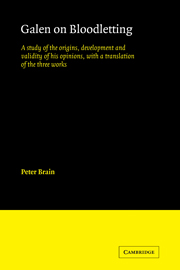 Galen on Bloodletting
Galen on Bloodletting Book contents
- Frontmatter
- Contents
- Preface
- Note on abbreviations and references
- Note on manuscripts and editions
- 1 Galen and his system: an introduction
- 2 Galen's Book on Venesection against Erasistratus (translation)
- 3 Galen's Book on Venesection against the Erasistrateans in Rome (translation)
- 4 Galen's Book on Treatment by Venesection (translation)
- 5 Development of Galen's views and methods as shown in the three works
- 6 Galen, venesection and the Hippocratic Corpus
- 7 Galen's practice of venesection
- 8 Galen's revulsive treatment and vascular anatomy
- 9 The testimony of other writers and the validity of Galen's opinions on sites for venesection
- 10 Galen's use of venesection as an evacuant: can it be justified? A medical digression
- 11 Conclusion
- Glossary
- Works cited
- Index
2 - Galen's Book on Venesection against Erasistratus (translation)
Published online by Cambridge University Press: 04 August 2010
- Frontmatter
- Contents
- Preface
- Note on abbreviations and references
- Note on manuscripts and editions
- 1 Galen and his system: an introduction
- 2 Galen's Book on Venesection against Erasistratus (translation)
- 3 Galen's Book on Venesection against the Erasistrateans in Rome (translation)
- 4 Galen's Book on Treatment by Venesection (translation)
- 5 Development of Galen's views and methods as shown in the three works
- 6 Galen, venesection and the Hippocratic Corpus
- 7 Galen's practice of venesection
- 8 Galen's revulsive treatment and vascular anatomy
- 9 The testimony of other writers and the validity of Galen's opinions on sites for venesection
- 10 Galen's use of venesection as an evacuant: can it be justified? A medical digression
- 11 Conclusion
- Glossary
- Works cited
- Index
Summary
The first chapter of the second bloodletting work (pp. 38–42 below) explains that this first book is a verbatim transcript of an address by Galen to a gathering of philosophers, in which he attacked Erasistratus. It was taken down, he says, at the request of a friend who wanted it for his private use, and was never intended for wider distribution.
It seems to me to be a question well worth investigating, why on earth Erasistratus, who was, after all, so competent in the other branches of the Art, and so meticulous about the minutest detail as to describe even the boiling of certain vegetables and of plasters – matters on which it would have sufficed any one else just to say what was essential and to omit the mode of preparation, as a minor point which anyone could pick up as he went along – why Erasistratus, in the case of such a powerful and important remedy as phlebotomy, and one that was esteemed by the ancients as in no way inferior to the most effective of all, has nothing to say. The fact is that the word K148 phlebotomy is scarcely to be found in any work of his; the one exception is in his book on bringing up blood, but even here he mentions it more, it would seem, in passing than as something he was considering with the care it deserves.
- Type
- Chapter
- Information
- Galen on BloodlettingA Study of the Origins, Development and Validity of his Opinions, with a Translation of the Three Works, pp. 15 - 37Publisher: Cambridge University PressPrint publication year: 1986


